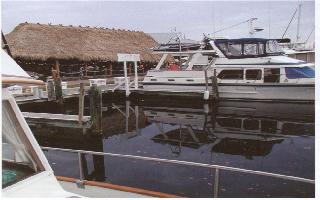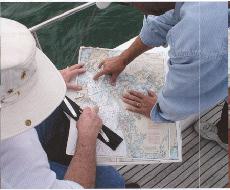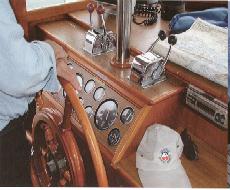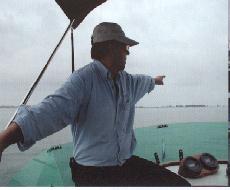|
Crash Course
Story and photos by
Steve Rosenberg
Want to boost your boat-handling skills?
Take a confidence-building cruising course.

As the rub rail of the 36-foot Grand Banks trawler
grabs the piling on the way into the slip, several
things happen. The first, and most obvious, is
the deafening screech of plastic and wood resisting
each other. The second, and most regrettable,
is a knee-jerk overcompensation of the port engine,
which quickly sends the boat careening toward
the opposite piling.
The third, and most memorable, is the enthusiastic
reaction of the happy-hour patrons of an open-air
tiki bar called Hurricane Harry's, who are just
50 feet away and clapping in appreciation for
the afternoon's student entertainment. It's this
particular detail of the Florida Sailing and Cruising
School that really makes you earn your stripes
- if you can dock it there, you can dock it anywhere.
So, with your forehead beading with perspiration,
but with a feeling of accomplishment at finally
parking the boat without serious damage to Blue
Note or any of the neighboring vessels, the
engines are shut down. But just when you think
it's time to tie off for the evening and, perhaps,
discreetly join the bar crowd in heavy disguise,
Capt. Joe Cote tells you to fire up the diesels
and try again. And this time, he says, how about
docking with the wind instead of against it? Uh,
right.
No matter what your level of boating experience,
there's always something you can learn. That's
where a cruising school might really benefit you.
It's especially interesting if you spend most
of your time on protected inland lakes or rivers,
where the skills needed to safely pilot even a
relatively big boat are somewhat limited. Learn
the local water peculiarities, commit the applicable
laws to memory, and check the gas gauge, and you're
well on your way to some stress-free boating.
But you can keep things fresh by getting to know
the more demanding challenges of coastal boating.
And don't you think it would be a good idea to
brush up on your technique while driving someone
else's boat?
So it's off to North Fort Myers, Florida, where
Barb and Vic Hansen have been teaching powerboat-handling
skills and sailing for the past 19 years. Safe
and responsible boating is a passion for them,
and they're spreading the word with every diploma
they issue for either their captain or first-mate
courses.
After signing in, gear is stowed in the forward
cabin and a quick orientation is given. Ever piloted
a boat this big? No. Ever handled a twin-screw?
No. Ever docked a boat on a windy day in front
of more than 20 people who have been drinking?
No. OK, you're set. Just study this large stack
of guides and the captain with join you at 7 a.m.
Check.
Since the boat has two staterooms, there is another
student assigned to this three-day live-aboard
session. Tom Lawnsby is your fellow student. Tom's
a former computer designer and RV enthusiast from
Texas. He's interested in seeing if he can transfer
his sailing skills to a cruiser from the expressed
purpose of making the Great Loop trek around the
northeastern quadrant of the United States. Talk
about aiming high. At last count, there were 145
locks he'd need to negotiate over the course of
more than nine months. You hit it off with your
shipmate at dinner, and after a quick study session,
you call it an early night.
 |
You've forgotten how great it is to sleep aboard
a boat. It's a deep, refreshing sleep that has
you up well before the alarm with coffee in hand
for a magnificent sunrise. It's a good day for
boating. Capt. Joe shows up right on time lugging
an armload of thick reference guides. You'll commit
large sections to memory over the next two days.
But despite the intimidating collection of required
reading, Capt. Joe quickly puts you at ease. He's
a captain for hire during parts of the year, moving
boats from cool places to warm places when their
owners want to enjoy the warm climate. During
the summer, he's an assistant dockmaster on the
Hudson River in New York. He's a boater's boater.
He's also a serious, but understanding, teacher.
You will be a better boater after your time with
him, whether you realize it at the time or not.
The morning is spent with the basics-knot tying,
gear location, equipment operation, boat nomenclature,
navigation signage for the Intracoastal Waterway,
and gaining a solid understanding of the various
systems on Blue Note. Nothing is too difficult
if you have even the most basic boating background,
so the morning flies by. When you complete a walk-through
on line handling, you see that you'll be casting
off in no time.
This is the stuff you came for. Shore power is
disconnected and stowed, and the generator is
fired up. From the fly bridge helm, you hear the
engines rumble to life, and it's time to shove
off. There's very little traffic in the marina-apparently
everyone knows when the students are about to
be sent out. It's the confidence-building portion
of the show, where you realize that a 36-footer
can be turned within its own length. It's where
you understand that you have the ability to maneuver
even in tight situations, with oncoming traffic,
and wind. At least you realize that in theory,
given the fact that there are no present tight
situations, no oncoming traffic, and very little
wind.
 |
Upon returning to the marina (see the aforementioned
docking fiasco) you shut down for the evening,
coiling deck lines and securing gear like a pro.
You meet your neighbors, Jim and Margie of Greenfield,
Indiana, who are taking the class to broaden their
horizons after years of river boating. They're
getting a serious kick out of the fact that their
boat is named Patience. The local dinner
joint is rocking, but exhaustion sets in as the
evening's assignment draws inevitably closer -
cram for your certification test, and plot tomorrow's
course. Several after-dinner hours are committed
to studying, and nobody argues when it's time
to retire for the night.
The sky is clear and the water is reasonable
calm as you exit the marina the next morning toward
the main channel with several porpoises playfully
chasing your wake. Since you're used to just tearing
across your home lake in any direction, the narrow
channels that surround this area take a little
getting used to. In many spots, the channel is
only slightly wider than two big boats, leaving
you feeling a little crunched as oncoming vessels
go by. This is one of the reasons the area is
so perfect for training, you really get extreme
examples to deal with. With Tom at the wheel,
you sight the channel markers so you can anticipate
turns and give Tom plenty of time to react. More
than once, other boaters use a little more than
their fair share of the dredged route.
 |
On a particularly tricky run, the traffic gets
ridiculously thick. Capt. Joe comments on the
gathering "armada" and points to a thick
black squall line offshore. Nothing gets past
this guy. "Everyone's trying to get out to
the water before the storm comes ashore. It'll
be even worse when coming back," he says.
But it's all part of the education as rights-of-way
are yielded and all your newly learned on-the-water
skills are put to the test. Find an anchorage
for lunch, while navigating around a treacherous
point and locating three unusual chart references
along the way. It keeps you busy and interested.
Especially when you're asked to triangulate your
location using a distant charted landmark. Nobody
warned you there would be math on this test.
Later that afternoon, back at the marina, Capt.
Joe throws questions at you like, "What do
you do - step by step - when certain warning light
comes on?" Yep, shut down the engine, throw
back the rug and climb down into the engine room.
You suspect there's a clogged water intake and
dismantle the filtering unit just like it said
in the boat's equipment manual. Good thing you
stayed up real late reading those extra few pages.
Capt. Joe nods in approval.
When everything is said and done, and asked and
answered, and tested and graded, you get the passing
marks you hoped for. But more importantly, you
know you've made yourself a better, more competent
boater. And any time you can do that, it's time
well spent.
|